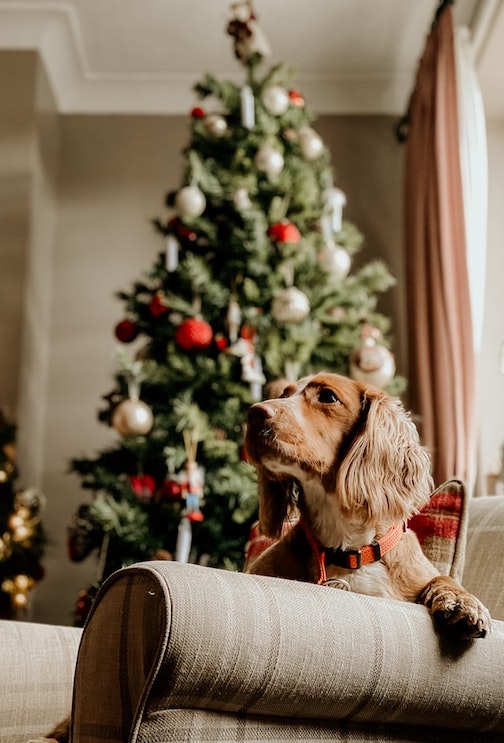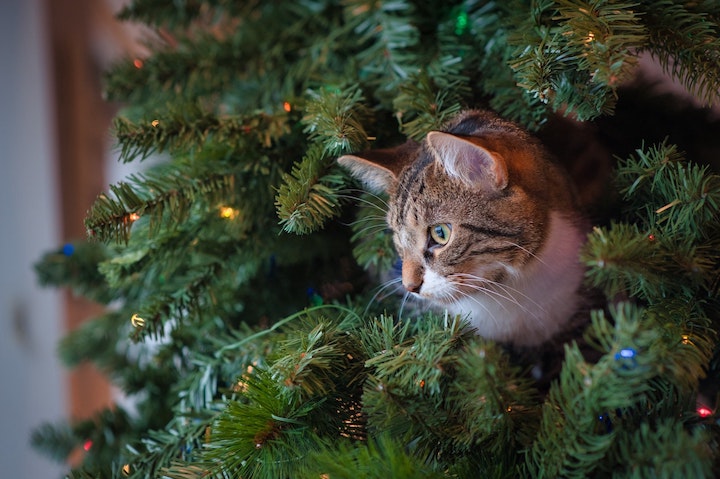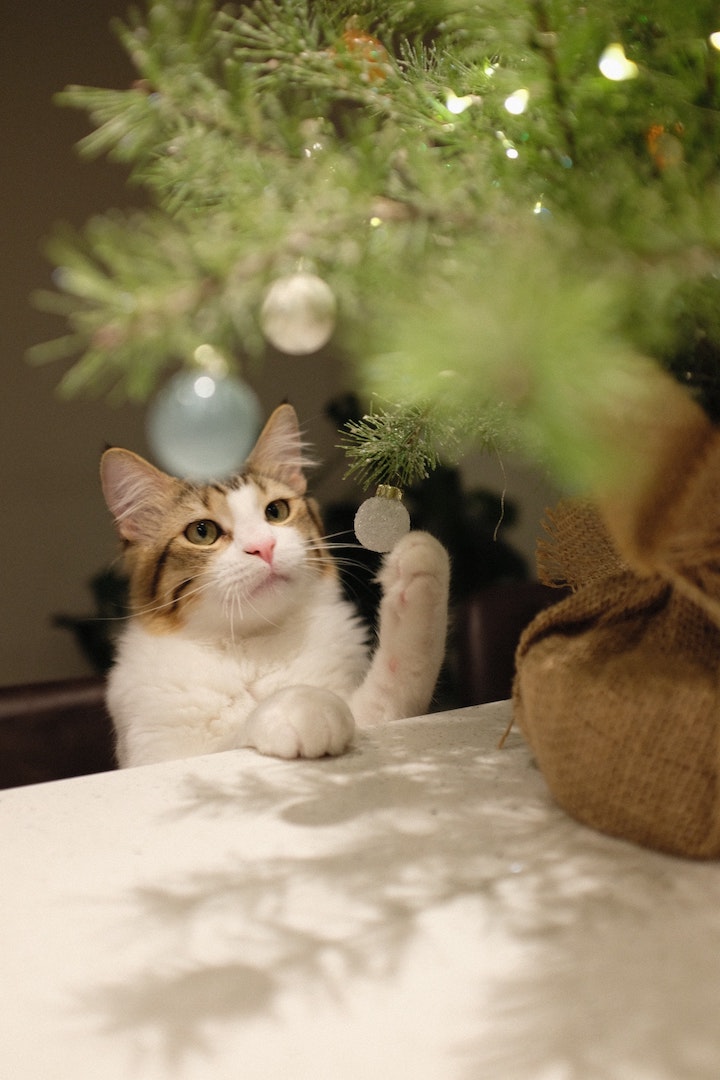8 Ways to Pet-Proof Your Christmas Tree
Posted: 05/23/2023 | BY: Erin Cain | Categories: Uncategorized
Although Christmas and the holiday season may look different for many people this year, you still want to make sure that wherever you’re celebrating is safe for your pets. All too many pet parents know the panic of taking a beloved furkid to the emergency clinic on Christmas eve or Christmas day. One of the most dangerous items for pets during the holidays is a real tree. It is the source of numerous accidents, injuries, upset stomachs, and expensive veterinary bills. Here are some ways to pet-proof your Christmas tree and keep the holidays safe for your pets.

1. Pet-proof the tree water.
If you are a family that rings in the holidays with a real tree, make sure you’ve taken the necessary steps to keep your pets away from it as much as possible. While you can’t police your tree at all times, you can eliminate some risks associated with real trees and pets.
First, use a covered tree water dish to prevent your dog or cat from ingesting tree water. Fertilizers, pesticides, bacteria, oils, insecticides, and other preservatives are often added to tree water to promote tree health. Unfortunately, these additives are poisonous to pets. Keep the tree water dish covered and have plenty of fresh bowls of water nearby, so your pets drink out of their bowls instead of the tree dish.
2. Regularly clean up tree needles.
Real trees shed needles, and any pets are prone to chewing or swallowing those needles. Tree needles are mildly toxic and not digestible; therefore, they can cause your pet stomach upset. In particular, fir and pine needles can cause dogs to drool excessively and vomit. In worst cases, a pet who swallows tree needles may suffer a puncture or obstruction in their gastrointestinal tract. Prevent these accidents from happening by regularly cleaning up any needles that have fallen on the ground around your tree.

3. Stabilize the tree.
Some pets ignore Christmas trees, while others view them as a personal playground or challenge. For example, if you have a cat who loves to climb or a dog who thinks the new tree that popped up in the living room is there for them to jump on, your tree probably isn’t going to be standing long. Consider connecting the top of the tree to the ceiling with a ceiling hook and high test fishing line to prevent the tree from tipping over when your cats or dogs are climbing in it or through it.
4. Keep lights and wires out of your pet’s reach.
Lights are a central decoration during the holiday season, but they can be dangerous and deadly for your pets. On the tree, avoid placing strings of light on the bottom of the tree as many types of strings can get hot and burn your pet. Additionally, keep the light string wires, cores, and any extension cords away from where a pet could chew on them, potentially causing shock or electrocution. Duct tape dangling or excess wires to the walls or secure them in electric tubing, so your pets don’t swat or bite them.
LED lights are the safest kind to use on a tree around pets because they are durable, cool to the touch, and energy-efficient. Remember always to turn off your tree’s lights before you go to bed so your pets won’t surprise you with a not-so-welcome gift in the middle of the night.

5. Use pet-safe ornaments.
Whenever possible, decorate your tree with ornaments that are shatterproof or unbreakable. Steer clear of glass, edible, moving or glittering ornaments, or at least place those items toward the top of your tree where it’s less likely your dog or cat will reach them. Clamp the ornaments to the tree by using pliers to pinch the ornament hooks to the branches.
Pets may chew on ornaments, resulting in cuts and punctures in the mouth, throat, stomach, or intestines. Avoid using tinsel or garland as these decorations can cause gastrointestinal upset and blockages if ingested by pets. The same goes for hooks on ornaments, which can easily be snagged by a passing tail or swallowed, leading to potential internal injuries. Use yarn or lightweight twine to hang your ornaments instead.
6. Repel your pets from the tree’s base.
Take steps to make your real tree less inviting to your cat or dog. For cats, wrap the tree’s base in tinfoil because cats hate climbing on it and dogs don’t like stepping on it; add a tightly wrapped tree skirt for extra coverage. Try placing orange peels around the base of the tree as cats and dogs dislike the smell of citrus.
7. Cordon off the tree entirely.
If your dog or cat is a master at getting to the tree, you may need to place it in a separate room that can be closed off from the rest of the house. If that is too drastic a step, consider placing baby gates or pet gates around the tree to stop your dog from getting near the tree. You can also crate your pets in another part of your home if they are persistent in their quest to access the tree.
8. Artificial trees can be dangerous, too.
What if you don’t have a real tree for the holidays, but an artificial one instead? Even with an artificial tree, many of the same tips above apply. Over time, artificial trees become brittle and break more easily. Pieces of plastic branches may fall off, and they pose just as much an obstruction danger to pets as the needles on a real tree.
Celebrate in safety with your pets this holiday season.
We all need as much joy as we can find this holiday season, so let’s celebrate with your pets in as safe a fashion as possible. Double check your real or artificial tree and make sure it’s properly pet-proofed so you and your furkids can have a winter celebration that focuses on what’s good in our lives.
No matter how careful we are as pet parents, accidents still happen. Ensure your pet has a pet insurance policy, so you don’t have to bear the burden of catastrophic veterinary bills. Don’t have insurance? Get a free, personalized quote today, and start the New Year off right with added protection for your pets.
References:
- Wagner, D. (2017). My Pet Drank Christmas Tree Water. Is That Harmful? Retrieved from http://granvillevet.com/my-pet-drank-christmas-tree-water-is-that-harmful/
- Farracelli, A. (2020). Why Do Dogs Eat Pine Needles? And How to Stop Them. Retrieved from https://petmaven.io/whydodogs/behavior/why-do-dogs-eat-pine-needles-and-how-to-stop-them-iRaxbkHf60mJSEDTzpk-3g
- Long Trail Veterinary Center. (2020). Pet-offensive odors: What their nose knows and what yours doesn’t. Retrieved from https://www.longtrailveterinarycenter.com/pet-offensive-odors-what-their-nose-knows-and-yours-doesnt
Disclaimer
The information contained on this blog is intended for informational and educational purposes only and should not be construed as medical advice. It is not a substitute for professional veterinary care. Always consult with your veterinarian before making any changes to your pet's health care or treatment plan.
The authors of this blog are not veterinarians and do not claim to be experts in pet health. The information provided here is based on our own experiences and research, as well as information from reputable sources. However, we cannot guarantee the accuracy or completeness of this information.
We encourage you to do your own research and consult with your veterinarian before making any decisions about your pet's health.
Previous post
Spoil Them Rotten This Holiday SeasonCompare top pet insurance providers plans.
Enter your dog’s age in years and months to calculate their age equivalent to human years.
Calculate your dog’s ageEnter your cat’s age in years and months to calculate their age equivalent to human years.
Calculate your cat’s age